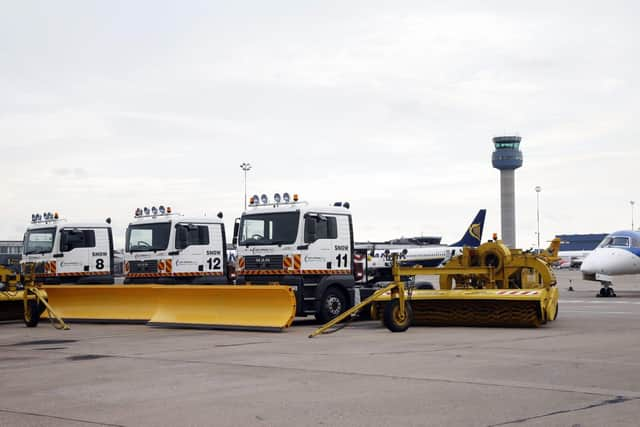East Midlands Airport is fully prepared to minimise the disruption caused by snow and ice
and live on Freeview channel 276
How does EMA prepare for winter weather?
At EMA we have the equivalent of 100 football pitches of tarmac on the airfield including the runway, taxiway and stands where planes park. It’s a huge operation to keep this free from snow and ice, which is why we start planning as far in advance as August.
That’s when we begin to run through our Winter Operations Plan, testing it with more than 80 staff from Airfield Operations, Firefighting and Air Traffic Control who are at the frontline of responding, as well as with many more members of staff across 14 teams, plus airlines and external contractors, who provide vital support when snow and ice affect operations.
Advertisement
Hide AdAdvertisement
Hide Ad

We ensure our fleet of snow ploughs and other equipment are ready to go, and that we have enough anti-icing fluid stored and ready to use.
At an airport, it's doubly important that we're vigilant, quick to react to changes and proactive with all precautions.
Why do snow and ice cause problems at the airport?
When snow covers the markings and lights on the runway, it is deemed that operational safety is compromised. Our teams carry out inspections every day and their vehicles carry advanced technology that helps them fully assess the conditions.
We also have to consider other parts of the airport such as car parks, bus station, roads and pavements, to ensure that people working at the airport, as well as our customers, remain safe. This is our number one priority.
How does EMA monitor the weather?
Advertisement
Hide AdAdvertisement
Hide AdOur teams are constantly checking a number of different monitoring systems to build up an accurate picture so we can be ready to take appropriate action.
We use sophisticated weather forecasting systems to make sure we can prepare for whatever the climate throws at us - this includes being aware of the exact air pressure around the airport, the precise level of clouds and more.
In the winter this helps us not only to have a good idea of when snow is likely to fall - but also to know what the temperature of the tarmac on the airfield is going to be. The temperature of the ground on a cold night is actually cooler than that of the air - so even if the air temperature is above zero, the temperature of the tarmac of the airfield can be below zero meaning moisture can quickly turn to ice.
How do you treat the airport - and airfield particularly - to minimise the effects of snow and ice?
Advertisement
Hide AdAdvertisement
Hide AdDuring winter months, teams are on standby to be quickly deployed whenever needed to make sure things stay running smoothly. The road network, footpaths and car parks around the airport are treated with grit and salt in the same way as other busy roads and pavements to make sure they're safe for users.
On the airfield it's a slightly different picture. Grit isn't suitable on airfields as it can damage aircraft and is corrosive. We have 100,000 litres of anti-icing fluid stored and ready to treat the runway to help prevent it from freezing. The surface is also slightly grooved to provide better traction for aircraft when it is wet or icy.
We will proactively deploy the anti-icing treatment to prevent some snow from building up, but that can still happen in heavy snow. That's when we rely on our fleet of snow clearing vehicles and workers trained to clear snow. We train staff to work with this equipment in inclement weather. They clear snow and ice as quickly and safely as possible to get flights and our customers moving again.
Our fleet of snow clearing vehicles includes tractors that can be equipped with a range of attachments including ploughs and brushes, and combined jet blowers that are fitted with ploughs, blowers and brushes.
Why does EMA have to stop operations when it snows?
Advertisement
Hide AdAdvertisement
Hide AdIf we experience what we call ‘white top’ – when the runway’s centre lines and lights can no longer be seen - we close the airfield due to safety concerns. Doing this allows us to mobilise our full fleet of snow ploughs and clear the runways more quickly.
How do airports in snowy countries operate? Why are they able to operate in much worse conditions than in this country?
There are lots of reasons - but a key one is that at temperatures around freezing point snow tends to be wetter because not all of it is frozen. This means it turns to slush and ice which is both more slippery and harder to clear. When the temperature is lower than -2c the snow is drier and more powdery and easier to clear or blow away.
What can I do as a customer?
We have our plans in place and our teams will work hard to take appropriate action swiftly and safely to get things running again. But our customers can also play a part – by taking extra care when travelling to and around the airport, checking the status of flights with their airlines and keeping an eye on social media for updates.